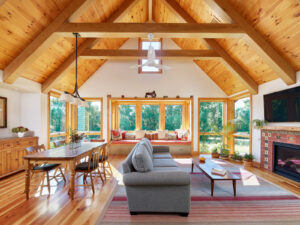Sustainability presents an inherent conflict to architects
Because the most sustainable thing you can do is … nothing. In the first of this two-part series, Jeff digs into what sustainability can look like assuming you do a bit more than “nothing.”
 Virtually all of what we do involves consumption of resources and acquisition of land for human habitation, whether living, working, or schooling. As an architect, one has to accept the fact that we’re going to be altering the natural environment and not necessarily in the most positive possible way. So for any architect who really cares about sustainability our role becomes one of ‘do the least amount of harm.’ That could mean restoring existing housing stock with green renovations, rather than building new.
Virtually all of what we do involves consumption of resources and acquisition of land for human habitation, whether living, working, or schooling. As an architect, one has to accept the fact that we’re going to be altering the natural environment and not necessarily in the most positive possible way. So for any architect who really cares about sustainability our role becomes one of ‘do the least amount of harm.’ That could mean restoring existing housing stock with green renovations, rather than building new.
Green renovations
Other environmentally friendly moves: Replacing old, inefficient heating systems with more efficient systems. Removing toxins such as lead paint, lead piping and asbestos from older structures. Restoring damaged landscape, removing invasive species. Removing hardscaping to mitigate stormwater runoff. Our practice includes an extensive amount of renovation work and we see that as an opportunity to do the least amount of harm … and in some cases enhance previous manmade interventions.
There is a LEED for Homes program and there are other sustainability certification programs; however, there’s a fair bit of cost involved to verify, performance-test and ultimately certify a project. Particularly with renovation work, it’s difficult to achieve certification unless we are doing a whole house renovation. So we take this approach regardless of whether someone has the intent to certify. A lot of the certification requirements are just good practice. That’s what we are doing.
Green is good
The benefits are many. Green renovations save homeowners money over the life of the investment. Sustainable means a healthier indoor environment; it’s better for the planet.
Another key part of sustainability to me is how a building responds to its environment. In renovations, there may be little to do in terms of solar orientation. But what we can do is enhance the amount of natural light that enters the house in an energy-efficient way.
Often, for sustainable renovations and additions, we’ll create a light-filled room for an early-20th century stone house, which wouldn’t typically have a lot of large openings or windows onto the landscape. This gives the home a connection from the inside to the natural landscape outside, and employs new, energy-efficient insulated windows—it’s “green” in two ways.
Read Part Two of this series, which discusses sustainable architecture for new homes.